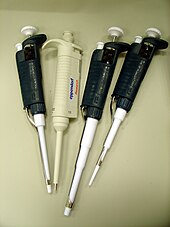Heinrich Schnitger
Heinrich Schnitger (born May 10, 1925 in Lemgo ; † August 27, 1964 in Upper Bavaria ) was a German medic . He is considered to be the inventor of the piston-operated pipette , a laboratory device for dispensing small amounts of liquid .
Life
Heinrich Schnitger in 1925 in Lippe Lemgo born, made in 1943 graduated from high school at the local Engelbert Kaempfer High School and was after studying medicine in 1956 at the University of Marburg with a work on the development of a device for automated determination of blood clotting times to the doctor of Doctorate in medicine . During his subsequent activity at the Physiological-Chemical Institute of the Marburg University, he was busy measuring large amounts of chromatography samples with a volume of less than one milliliter each for further analysis. The usual procedure at that time was the use of thin glass pipettes, in which the liquids were sucked in directly or through a hose with the mouth.
In the spring of 1957, Heinrich Schnitger, in cooperation with the mechanical workshop of the institute, designed a new type of device for this activity, which made it possible to dose small quantities of liquid quickly and precisely by hand. In the same year he submitted a patent to the German Patent Office entitled “Device for the rapid and precise pipetting of small amounts of liquid” , which was granted in 1961. The Eppendorf company further improved the device, initially called the “Marburg pipette”, in collaboration with Heinrich Schnitger, and after the exclusive licensing of the patent took over the marketing.
Heinrich Schnitger was killed in an accident while swimming in the Eibsee (near the Zugspitze) in Upper Bavaria in 1964, and thus before the worldwide spread of his invention .
Meaning of his invention
The micropipette developed by Heinrich Schnitger, which is often referred to as the "Eppendorf pipette" in laboratory parlance, is now a part of the basic equipment of almost every biomedical laboratory. For biologists , biochemists , biology laboratory assistants , medical-technical assistants and similar professions, the handling of these devices is an elementary part of their training and often a daily part of their work. For manual dosing of small volumes in the field of biomedical research, clinical chemistry as well as environmental and food analysis, micropipettes have almost completely replaced other processes due to their ease of use and their precision.
The most important contribution made by Eppendorf, through which the commercial success of the piston-operated pipette was made possible, was the development of interchangeable pipette tips made of polyethylene and polypropylene . In the early 1970s, the American company Gilson , which attached little importance to Schnitger's invention, launched the first piston-operated pipettes with variably adjustable pipetting volumes, which are currently the most frequently used form. Further variants based on the basic principle developed by Heinrich Schnitger are so-called multi-channel pipettes for simultaneous dosing via eight or twelve channels as well as pipettes with electronic setting and control of the dosing.
More inventions
In addition to the piston-operated pipette, Heinrich Schnitger also invented a coagulometer for measuring blood clotting times , a hose clamp and hose pumps for chromatography .
literature
- Birgit Pfeiffer: The “Marburg Pipette”. The history and creation of the piston-stroke pipette. Dissertation at the Medical Faculty of the Philipps University of Marburg, Marburg 2004.
- Birgit Pfeiffer, Jan Koolman: The invention of the microliter pipette. In: BIOspectrum. 11 (4 )/2005. Spektrum Akademischer Verlag, p. 467, ISSN 0947-0867
- Martin Klingenberg: When a Common Problem Meets an Ingenious Mind. In: EMBO Reports. 6 (9 )/2005. European Molecular Biology Organization, pp. 797-800, ISSN 1469-221X
- Anja Scholzen: The revolution came from Marburg. Pipetting, but correctly: The invention of the piston-operated pipette 38 years ago went around the world. In: Marburger UniJournal. No. 21 of April 2005. Published by the Philipps University of Marburg, pp. 58-60, ISSN 1616-1807
Individual evidence
- ↑ Jörg Hagemann: Lemgoer Genius revolutionizes laboratory research , in: Lippische Landes-Zeitung , number 180/2020 of August 5, 2020, volume 254, p. 14.
| personal data | |
|---|---|
| SURNAME | Schnitger, Heinrich |
| BRIEF DESCRIPTION | German physician and inventor of the piston-operated pipette |
| DATE OF BIRTH | May 10, 1925 |
| PLACE OF BIRTH | Lemgo |
| DATE OF DEATH | August 27, 1964 |
| Place of death | Upper Bavaria |
